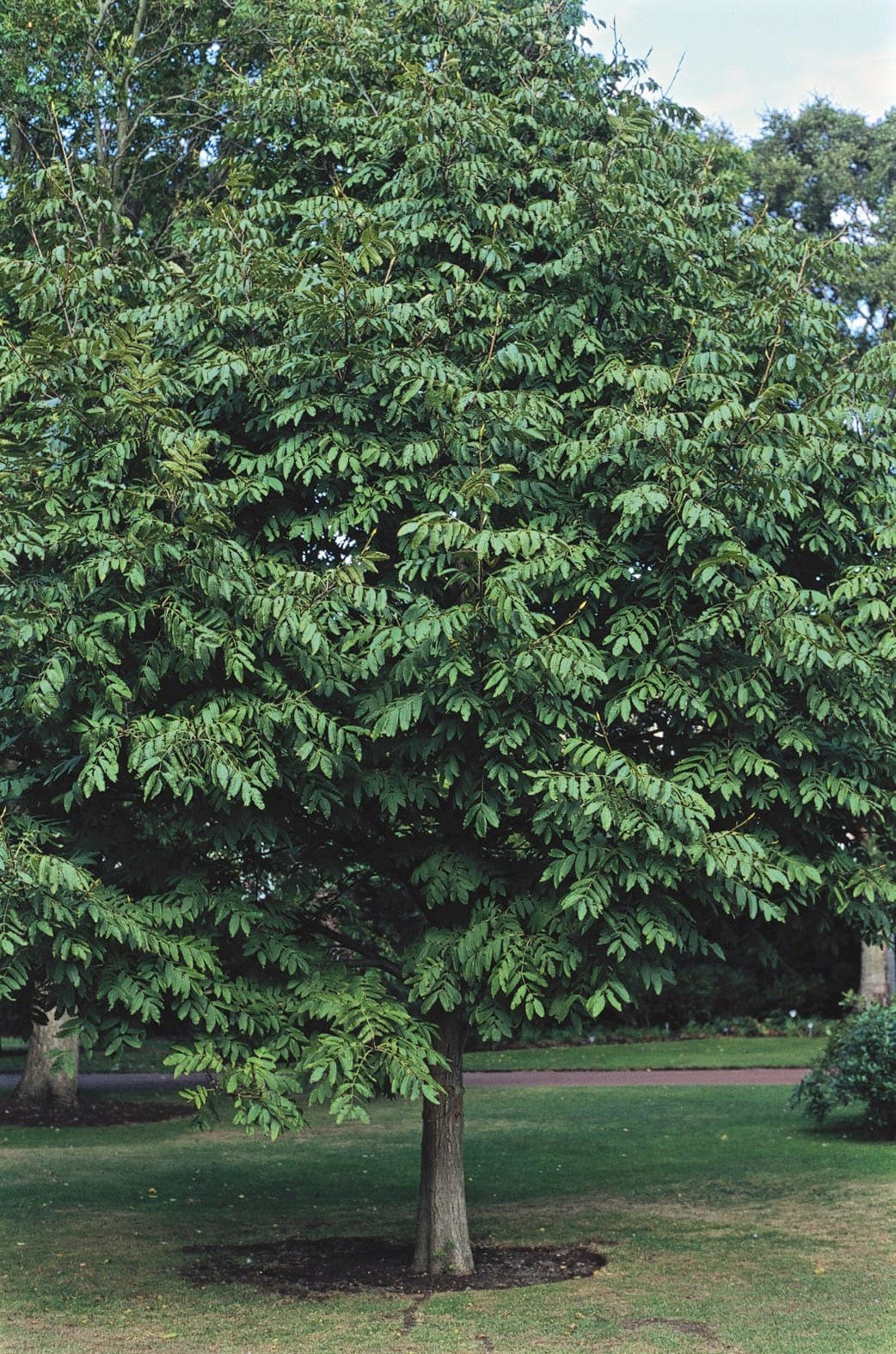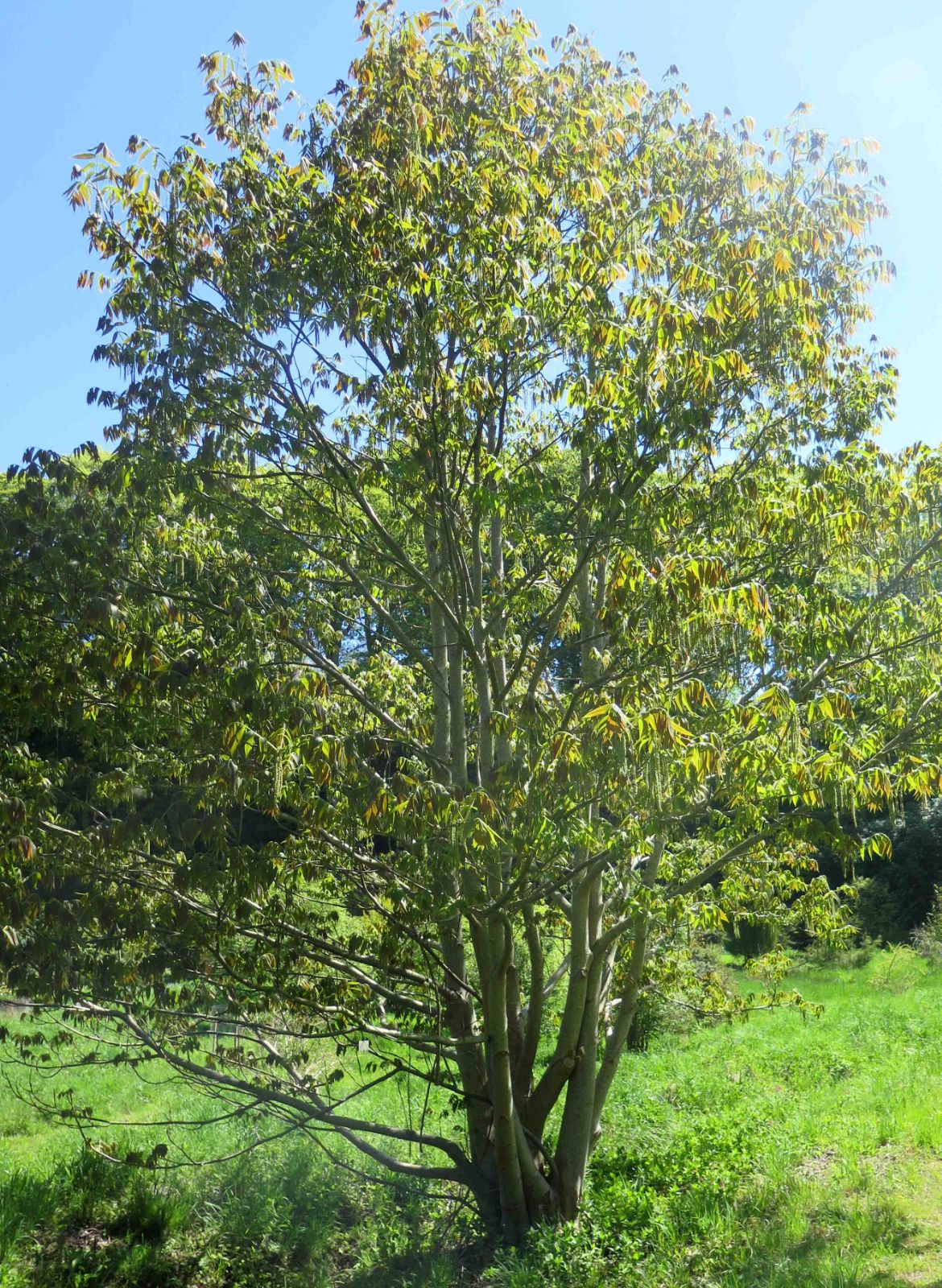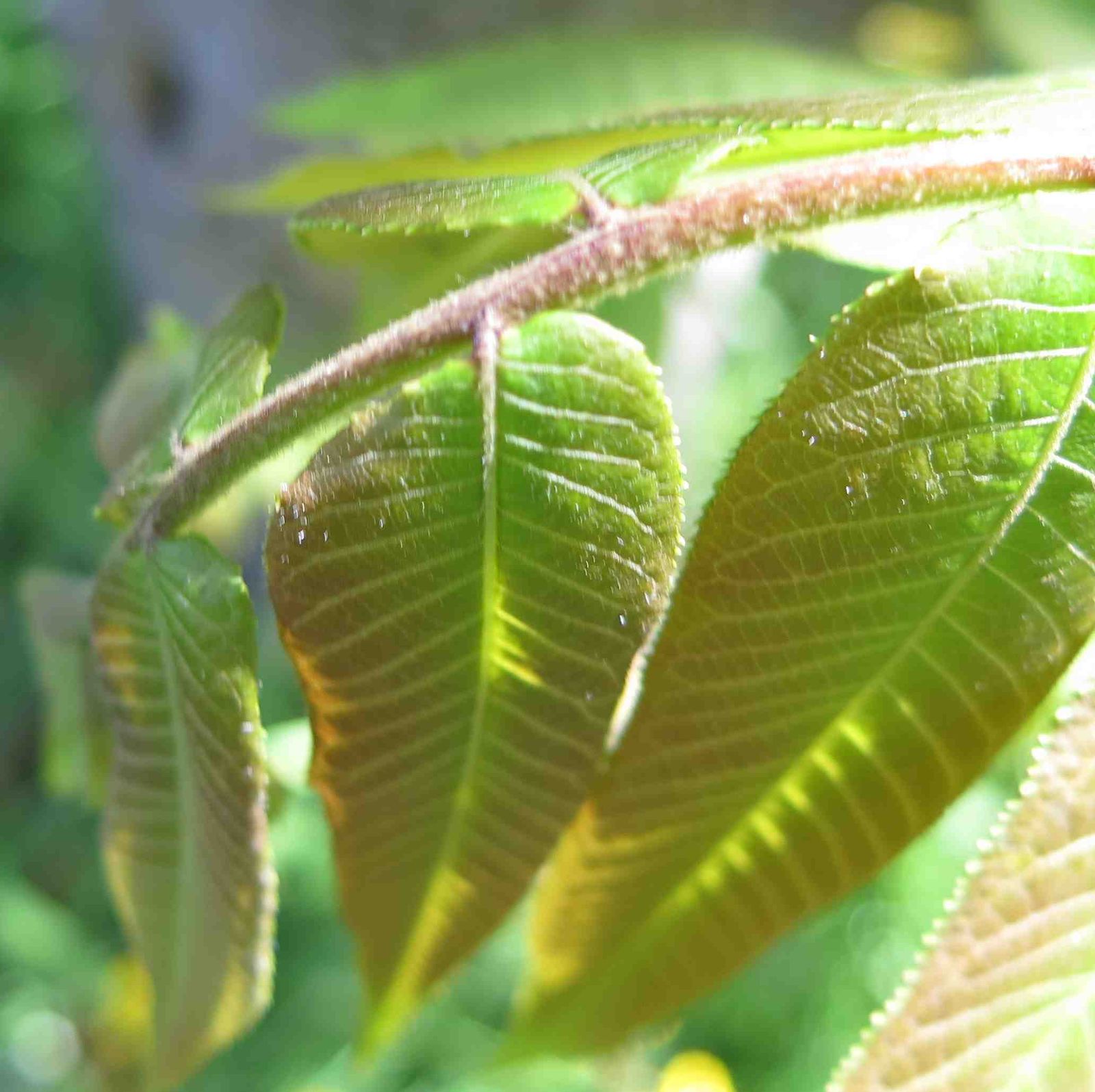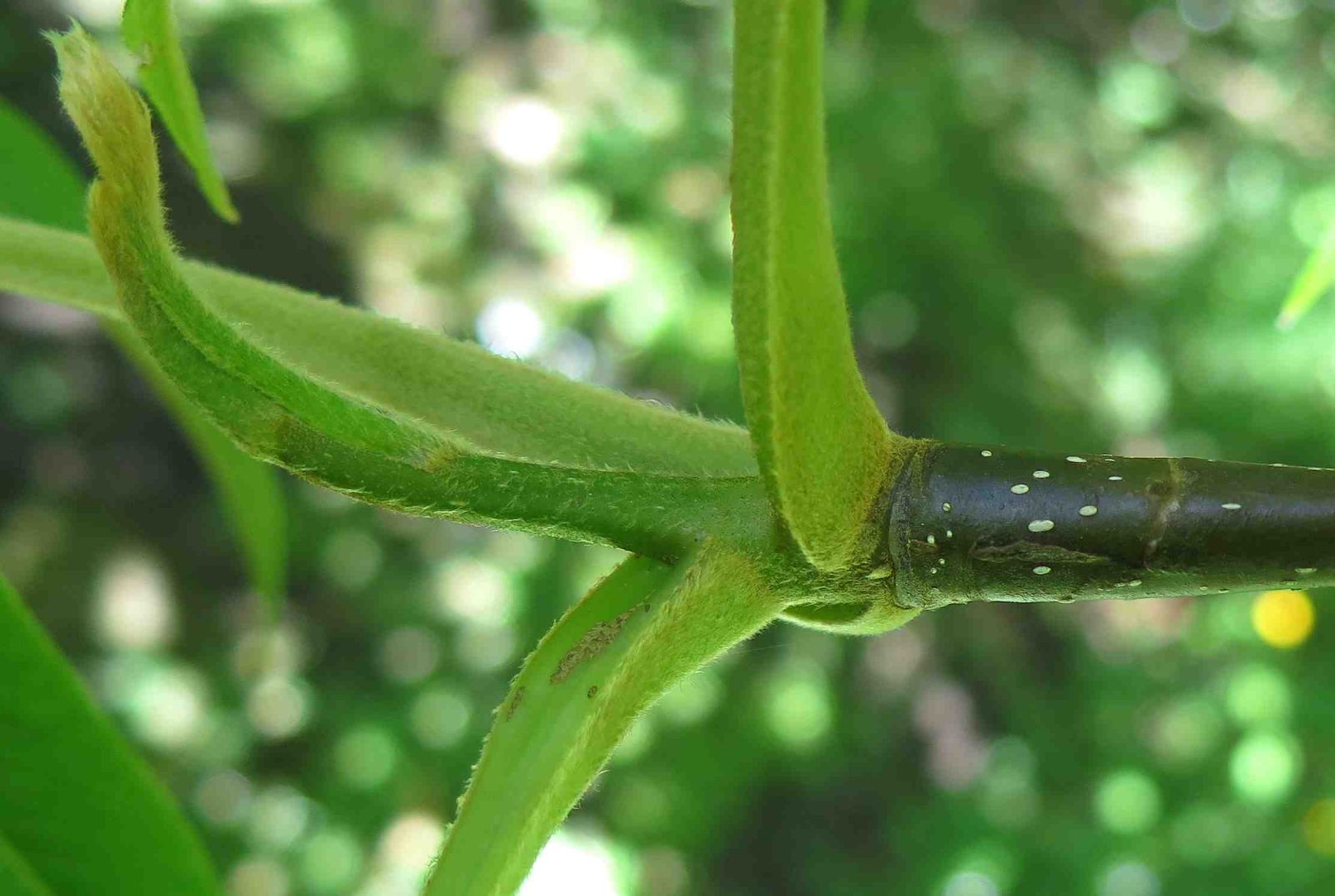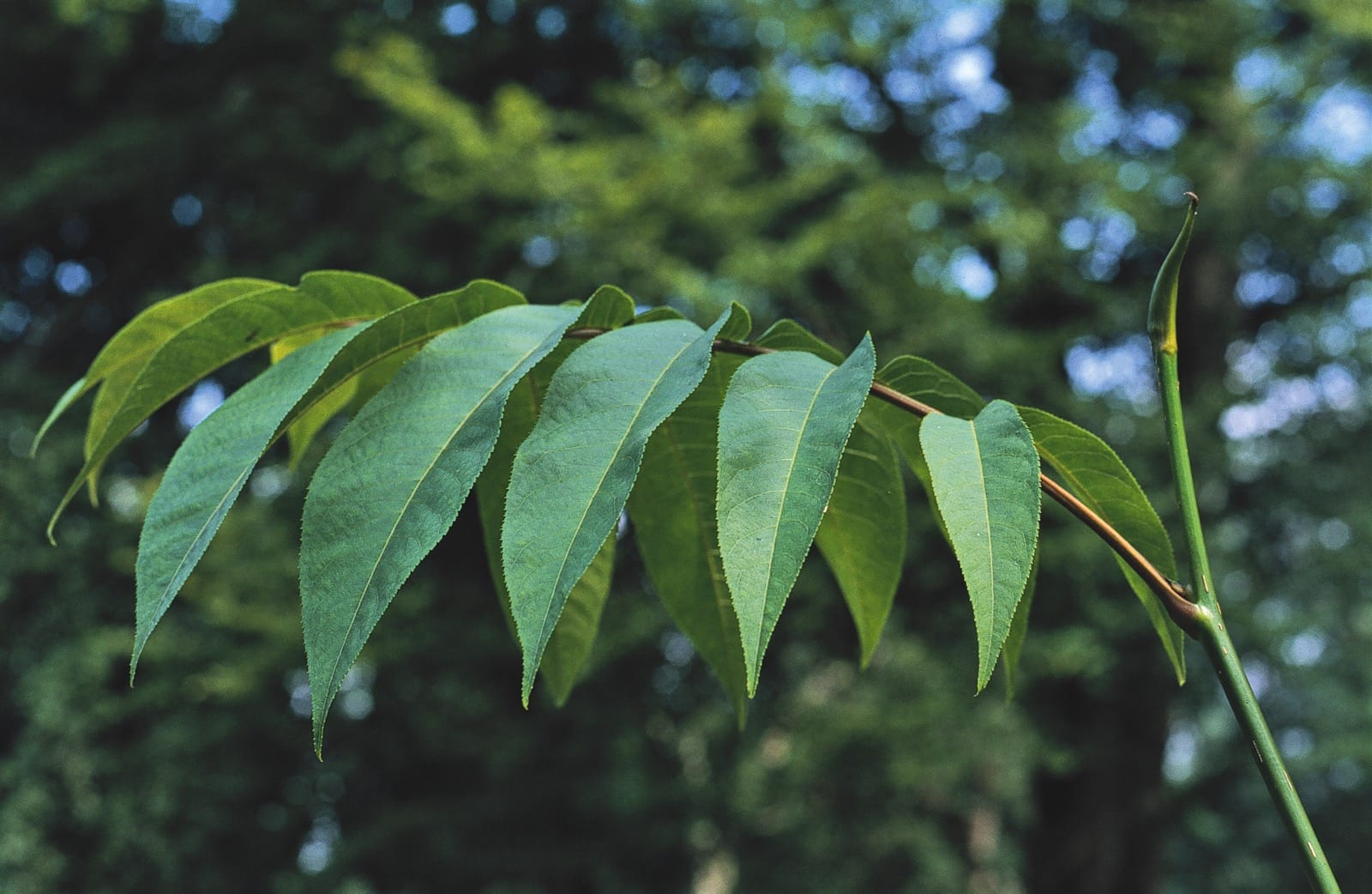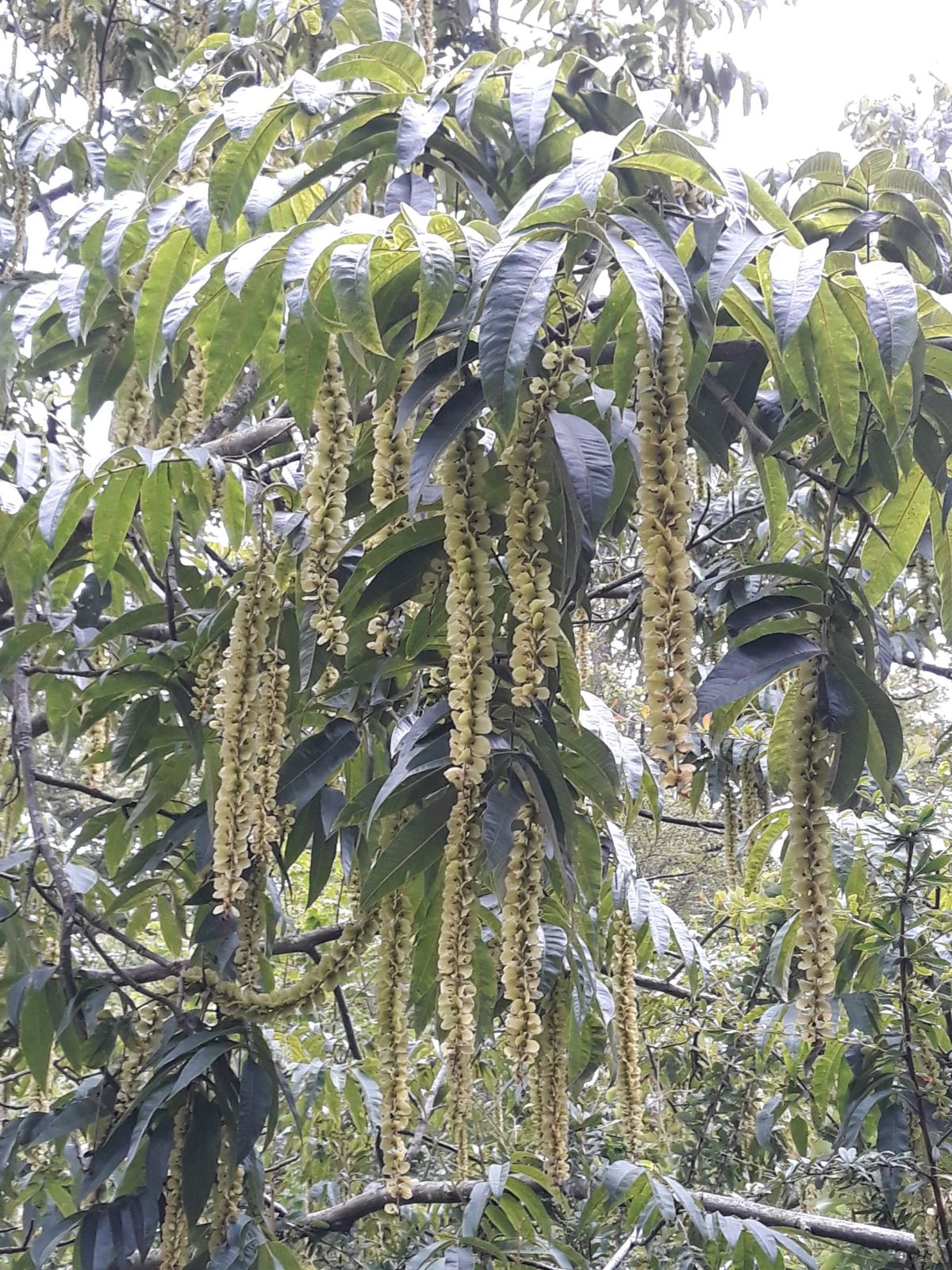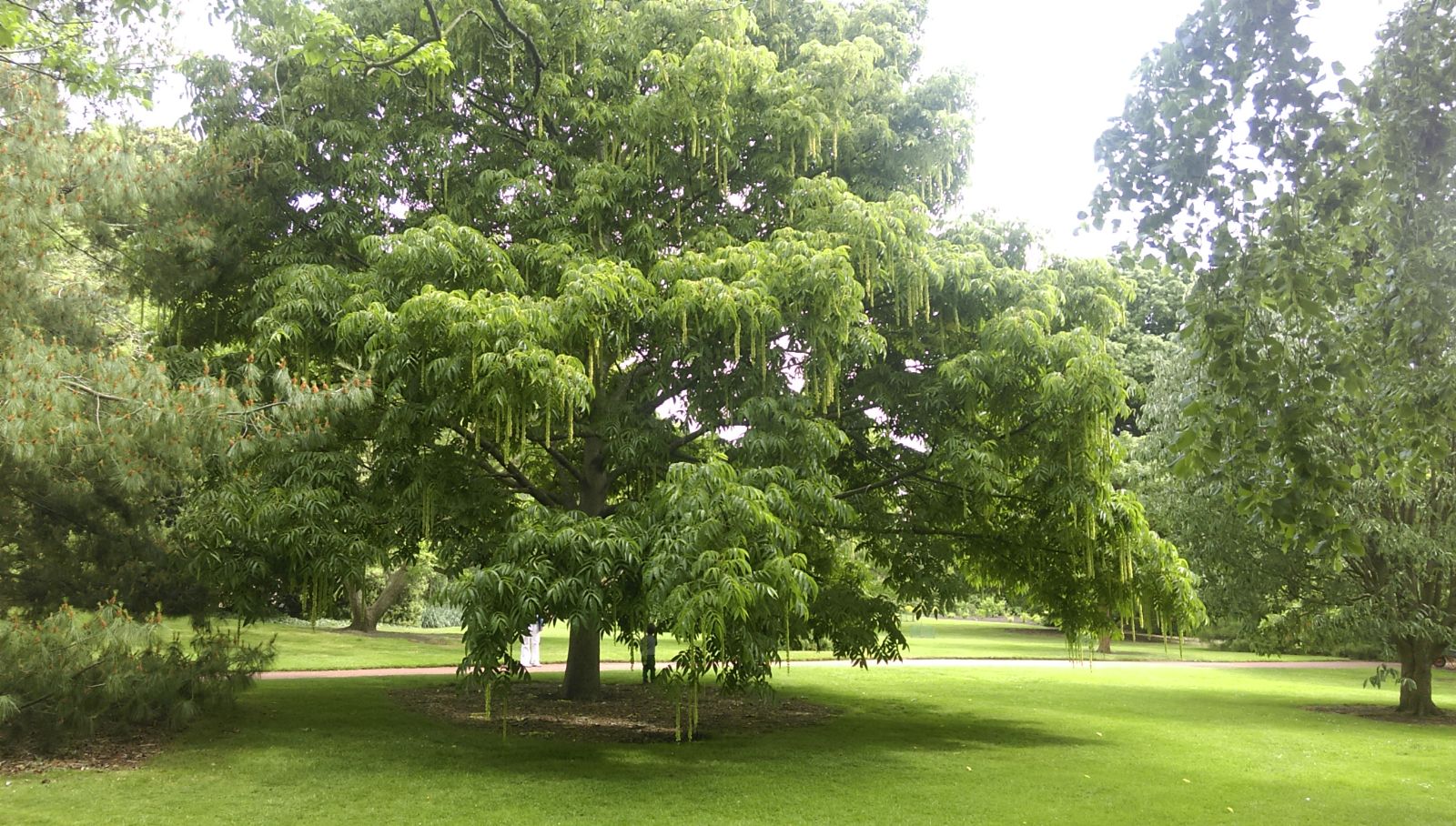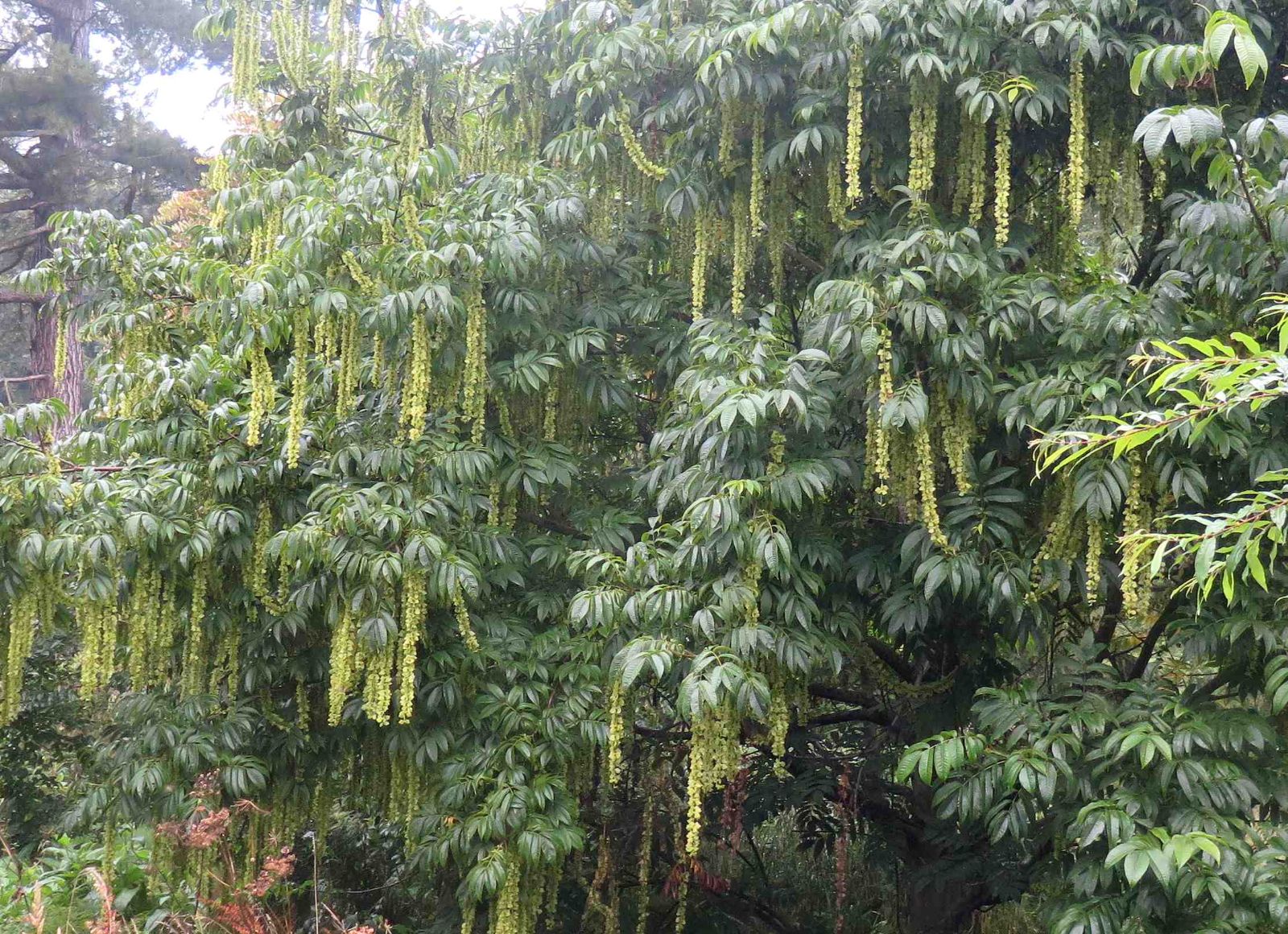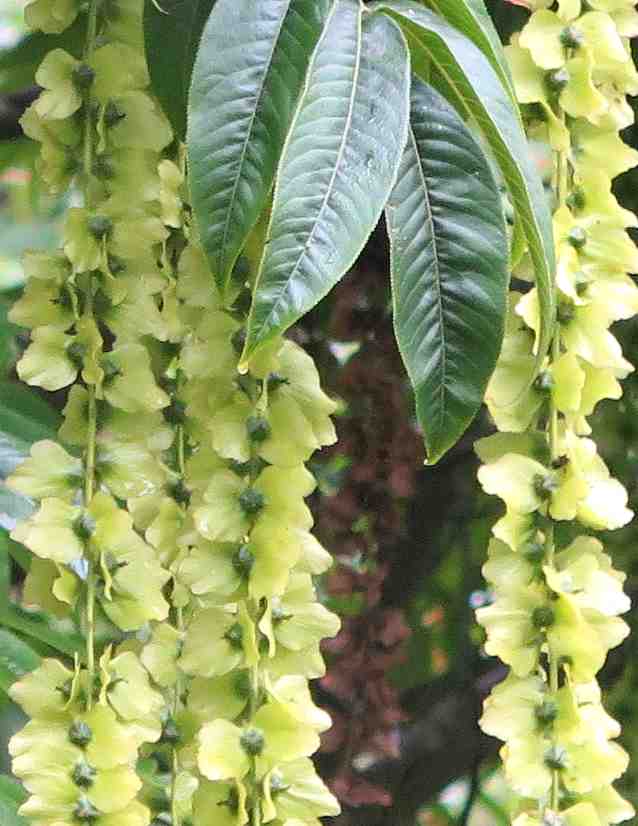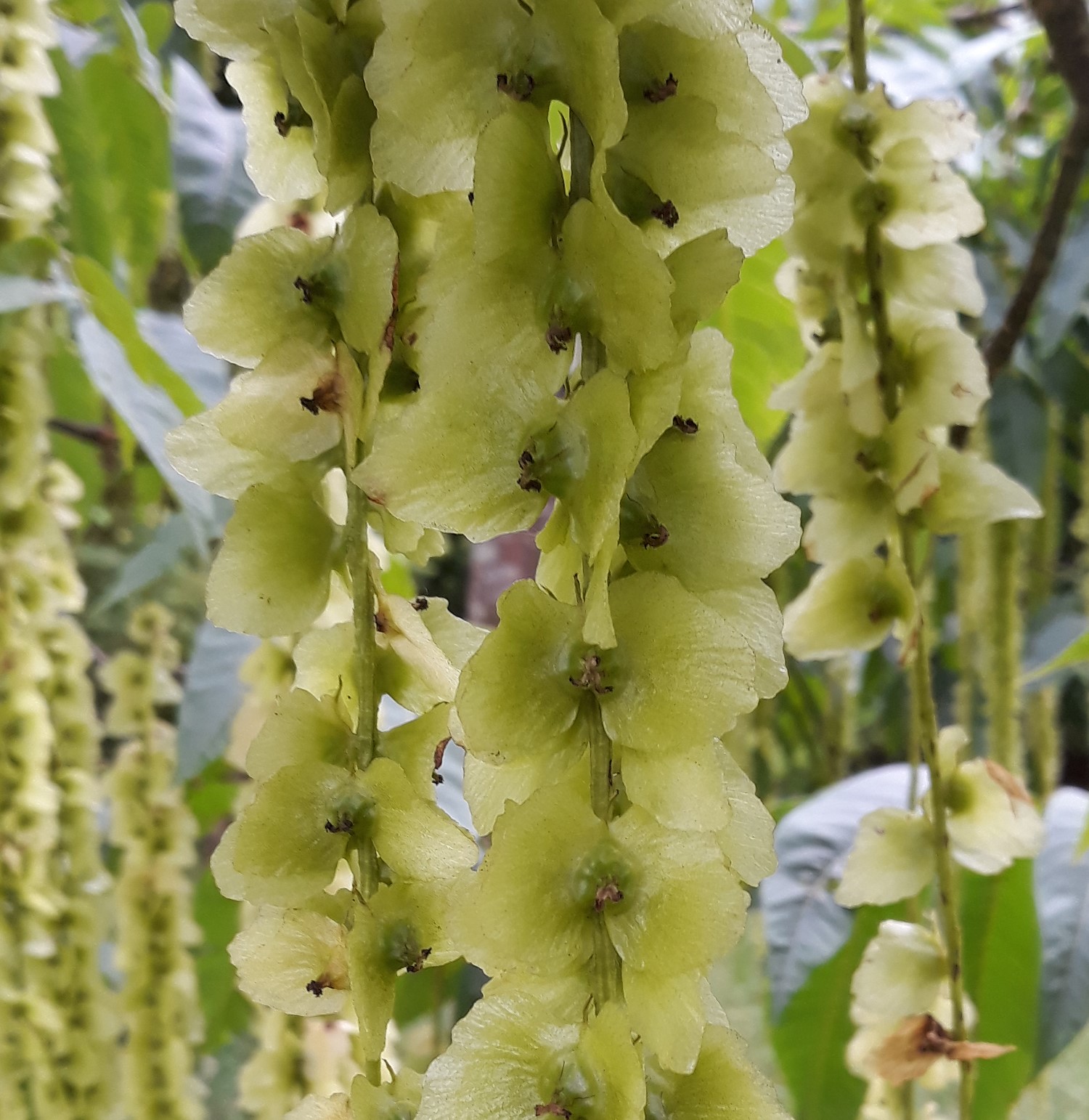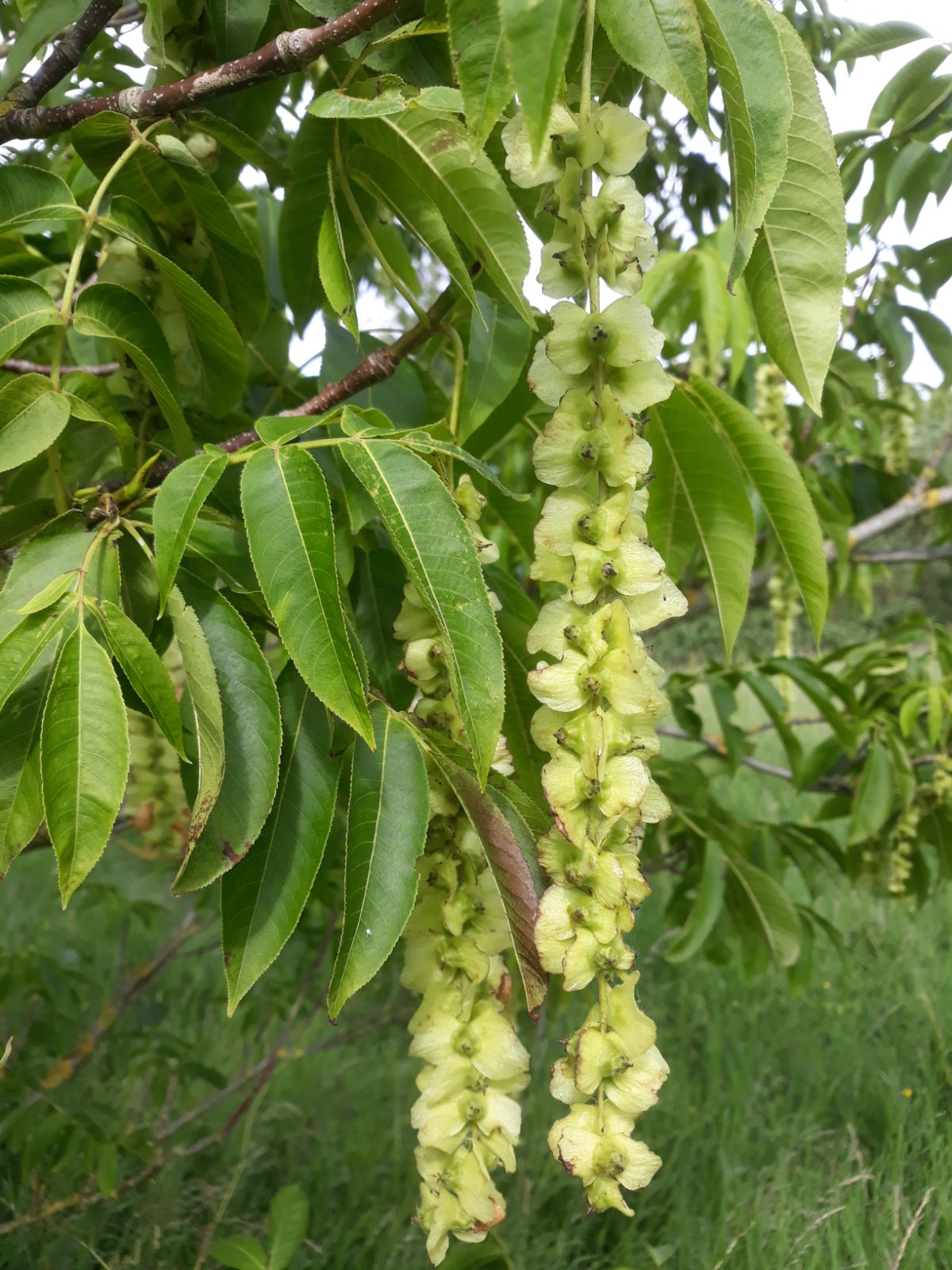Pterocarya macroptera
Sponsor
Kindly sponsored by
a member of the International Dendrology Society
Credits
Julian Sutton (2019)
Recommended citation
Sutton, J. (2019), 'Pterocarya macroptera' from the website Trees and Shrubs Online (treesandshrubsonline.
Genus
Common Names
- Large-Winged Wingnut
- gan su feng yan
Tree to 15 m. Bark light grey-brown, with longitudinal striations. Terminal buds green, brownish in winter, to 10 cm, bud scales shed early. Leaves imparipinnate, 20–52 cm, dark green, paler below. Rachis wingless, tomentose; leaflets 5–21, elliptic or elliptic-ovate to elliptic-lanceolate, 7–21.5 × 3–6 cm, base oblique, slightly cordate to broadly cuneate, apex acute or acuminate, usually glabrous when mature except for hairs on the midrib below, axillary tufts sometimes present; petiole 5–13 cm with narrow ridges. Male catkin to 15 cm, female 50–70 cm, axis tomentose. Nutlets c. 8 mm, tomentose, wings orbicular-ovate to elliptic, 1–2.5 × 1–1.3 cm. Flowers May–June (UK), fruit August–October (UK). (Lu et al. 1999; Rix 2007; Grimshaw & Bayton 2009; Kozlowski et al. 2018).
Distribution China SE Gansu, W Hubei, Shaanxi, Sichuan, Xizang, NW Yunnan, Zhejiang
Habitat Forests in river valleys, along mountain streams and on slopes; 1100–3500 m.
USDA Hardiness Zone 5-8
RHS Hardiness Rating H5
Conservation status Not evaluated (NE)
Pterocarya macroptera is widespread in central China, but is less clearly a riparian tree than many species. It is typically seen as scattered individuals in species-rich forests in the upper reaches of river valleys, rather than forming dense stands on flat, wet, valley bottoms. Despite its wide distribution, no more than 120 scattered populations are known, each comprising less than 50 individual trees, with little seed regeneration, although its relatively high altitude habitats are not under serious threat (Kozlowski et al. 2018).
Batalin’s specific epithet of 1893 refers to the large wings of the nutlets, from the Greek makros (large) and pteron (feather or wing).
Three varieties are recognised by Flora of China (Lu et al. 1999). They have somewhat different natural ranges but their morphological distinctions are rather slight. At one time they were treated as distinct species, and this question is not entirely settled (Kozlowski et al. 2018). The phylogenetic work of Mostajeran et al. (2017) indicates that var. delavayi may not be closely related to the other two. They are not easy to recognise in cultivation, especially if sterile. The following key is adapted from the Flora of China account.
Trees labelled Pterocarya macroptera are not infrequent in cultivation, but are often not attributed to variety. Var. delavayi is a rare tree, probably due to its tenderness, while fertile material is required to distinguish accurately between var. macroptera and var. delavayi: provenance is probably the most important character. Both var. macroptera and var. insignis form handsome, broad-crowned, single-stemmed trees that show no sign of suckering, and are well worth planting. Var. insignis is by far the most widely tested.
var. delavayi (Franch.) W.E. Manning
Synonyms
Pterocarya delavayi Franch.
Pterocarya forrestii W.W. Sm.
Tree to 15 m. Bark light grey-brown, with longitudinal striations. Terminal buds green, brownish in winter, to 10 cm. Leaves 20–52 cm, dark green, paler below, leaflets 7–21, elliptic or elliptic-ovate to elliptic-lanceolate, 7–21.5 × 3–6 cm, base oblique, slightly cordate to broadly cuneate, apex acute or acuminate, usually glabrous when mature except for hairs on the midrib below, axillary tufts sometimes present; petiole 5–13 cm with narrow ridges. Infructescence 50–60 cm, axis tomentose. Nutlets c. 8 mm, tomentose, wings orbicular-ovate to elliptic, 1–2.5 × 1–1.3 cm (Lu et al. 1999).
Distribution
- China – Western Hubei, western Sichuan, Xizang, northwest Yunnan.
RHS Hardiness Rating: H4
USDA Hardiness Zone: 7-8
var. delavayi is extremely variable, with the leaves especially varying in number, size and shape of the leaflets. It is well represented in herbaria by the collections of Forrest and Rock from Yunnan but remains scarce in cultivation, probably because it seems to be rather tender. One early collection survives at RBG Edinburgh, a 12 m (2014) specimen repropagated from F 13378 (The Tree Register 2019). A collection made by Brickell and Leslie (B&L 12575), as P. forrestii, in a wooded valley on the Cangshan above Dali, Yunnan, was distributed to various arboreta in the UK, but has died out in most. One specimen survives at Hergest Croft, and when young its new shoots were invariably killed by spring frosts, although they grew out vigorously later; in recent years, however, with increasing size, it has escaped significant damage (L. Banks pers. comm. 2006), reaching 10 m × 22 cm in 2013 (The Tree Register 2019).
var. insignis (Rehder & E.H. Wilson) W.E. Manning
Synonyms
Pterocarya insignis Rehder & E.H. Wilson
Tree to 25 m, spreading to 16 m (SICH 1751), to 3 m dbh (W.P. Fang 2721, from Emei Shan). Bark grey, fissured. Terminal buds yellow-green. Leaves (20–)30–45 cm, mid-green, densely pubescent; leaflets (5–)7–13, ovate to elongate-elliptic, 14–29 × 4–6 cm, base oblique, rounded, apex acuminate, glabrous except for veins and axillary tufts below; petiole 2–6 cm. Infructescence to 70 cm (but to 1.2 m in cultivation), axis glabrous or nearly so. Nutlets c. 8 mm, glabrous, wings orbicular-ovate, 1.5(–2) × 2(–2.5) cm. (Lu et al. 1999; Rix 2007).
Distribution
- China – Western Hubei, Shaanxi, Sichuan, northwest Yunnan, Zhejiang.
RHS Hardiness Rating: H5
USDA Hardiness Zone: 7-8
Pterocarya insignis, as it was then called, was first collected in 1908 by Wilson, from a single tree on the Wa-Shan, Sichuan, as W 3212 (Sargent 1917; Rix 2007), but no living specimens from early collections have been traced. Several collections of var. insignis have been made more recently in Sichuan including SICH 1468, 1751, 2156 and most notably 1205. Material from these is now well established in cultivation (Rix 2007; Foster 2019). From these trees it is clear that this taxon is quite variable, and the character of petiole length is seen to be somewhat unreliable. One specimen of SICH 1205 planted at Kew in 1995 (1995–636) has ‘authentic’ short petioles, but another (1995–2284) has petioles up to 14 cm long (Grimshaw & Bayton 2009).
This variety is proving to be a fast growing and adaptable tree in Britain. Foster (2019) notes that individuals from SICH 1205, planted around the same time at Kew, Wakehurst, Howick Hall and Thenford House, Northamptonshire, have grown at similar rates despite significant differences in climate and soils (heights 10–11 m in 2019, The Tree Register 2019). Moreover, Foster mentions an 11 m tree in his own Kent garden continuing to grow well during the drought of 2018, despite being in a light, stony soil. This species, in all its varieties, is little tested in North America. However, specimens from SICH 1205 are recorded at both the David C. Lam Asian Garden, Vancouver (University of British Columbia 2019) and Quarryhill Botanical Garden, California (Rix 2007).
Spectacular infructescences often up to a metre in length, with a record to date of 1.24 m (at Hergest Croft in 2021, C. Sanders pers. comm. 2021), lack of suckers and ability to cope with diverse conditions make this an ornamental tree of great potential, which is beginning to receive attention in the wider gardening literature (Foster 2019; Sutton 2019), and it may even have value as a forestry species.
var. macroptera
Tree to 15 m. Bark greyish-brown, striated when young. Young shoots more or less glabrous, with long internodes, green with white lenticels, becoming brown later, terminal buds conspicuous, bright green. Leaves 23–30(–60) cm, dull mid-green, paler below, with narrow ridges at sides, pubescent; rachis pubescent; leaflets 7–17, lateral leaflets elliptic or elongate-elliptic, 9–21 × 3–6 cm, base oblique, cordate, apex acuminate, glabrous except for veins and whitish tufts of hairs in vein axils below; petiole 4–8 cm. Infructescence 45–70 cm, axis tomentose. Nutlets 7–9 mm, tomentose, wings elliptic-rhomboid, 2–3 × 2–2.5 cm (Lu et al. 1999).
Distribution
- China – Southeast Gansu, southern Shaanxi, northeast Sichuan.
RHS Hardiness Rating: H5
USDA Hardiness Zone: 7-8
It is not always clear whether cultivated trees labelled P. macroptera represent this variety, or var. insignis. Fruiting material and ideally provenance are required for identification. It is very clear, however, that var. macroptera is by far the less common. A tree originating from Gansu was received at Kew as a seedling from the Chinese Academy of Forestry in 1979, and is almost certainly correctly identified as var. macroptera. Planted out in 1983, it was a shapely tree 8–9 m tall when seen in 2003; in July 2003 it was almost completely defoliated (probably the result of hot, dry weather), but it recovered in subsequent seasons (Grimshaw & Bayton 2009), and by 2010 had reached 11 m × 22 cm (The Tree Register 2019). A moist situation would seem preferable.

